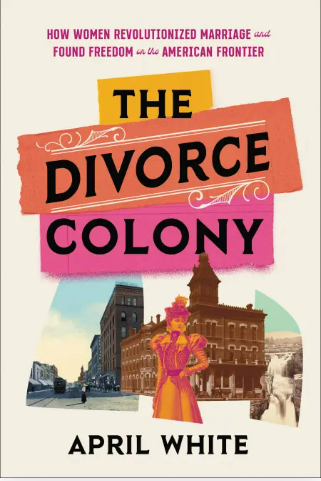When Sioux Falls was a 'Divorce Colony': New book showcases special history of Sioux Falls
April White never set out to write a book about Sioux Falls’s so-called ‘Divorce Colony,’ but while she was researching a con-man, she stumbled across a newspaper story about a woman who had recently returned from the colony.
“It just made me take a left turn,” she said. “What I really loved about the story when I first found it was just kind of the gossip of it, like just how scandalous and fun it seemed from a distance. But then I got into it and Sioux Falls plays this really important role in shaping how we think about divorce in the country today.”

In her new book “The Divorce Colony” White follows the story of four East Coast women who moved to Sioux Falls between a 20-year period at the turn of the century to end their marriages because of South Dakota’s lax divorce laws. Within the pages are competing thoughts on marriage and divorce at the time, lively descriptions of key locations in Sioux Falls and each woman’s choice to find freedom.
‘Center of the divorce debate’
Women of means between the end of the 19th century and the 20th century would travel from the east coast to Sioux Falls in order to start their divorce journey.
White used the women’s 40-hour journey along the North Shore Limited rail line to start the book to establish what each woman experienced.
“I wanted people to understand what it would have felt like for these women,” she said. “I wanted people to really have a grounding in the place and understand what the experience of going and living in this place for six months a year away from your family, like what it felt like, and I wanted to make that as real as possible for the reader.”
More: NWS has already issued highest number of thunderstorm warnings for South Dakota in single year
In the late 1800s, in order to obtain a divorce from a judge in South Dakota, men and women had to reside in the state for at least three months before making the initial divorce petition. By 1893, though, anyone wishing to get a divorce had to live in the state for six months.
That sent some travelers to North Dakota, who still had a three month residential requirement, before changing to one year in 1899. South Dakota at the same time kept the six month requirement and the divorce colony returned.
White used debates in state legislatures to color her description of what people in power thought about divorce at the time with Sioux Falls, often overlooked by historians, caught in the middle.

“Sioux Falls loomed incredibly large in the public imagination for almost 20 years,” White said. “From 1891 through 1908, it was the center of the divorce debate and divorce was the culture war of the 20th century."
As the times changed, White said she could see a greater acceptance of divorce and an understanding that it would become part of society during her research process.
Searching through century-old records
White first visited Sioux Falls nine years ago to start researching the divorce colony. She sat in the Minnehaha Clerk of Courts office with leather-bound docket books that held descriptions of every divorce case heard in the county.
She also took a trip to the Old Courthouse Museum to see where the divorce trials were heard.
“It was just super amazing to be able to stand in the room where these divorce trials took place. That courtroom looks almost identical, not the paint job, but everything else,” she said.
More: South Dakota Democrats see open AG, secretary of state contests as paths to statewide office
During her research process, White chose to highlight four women: Maggie De Stuers, Mary Nevins Blaine, Blanche Molineux and Flora Bigelow Dodge, who all represented the 20-years of the divorce debate in Sioux Falls and around the country.
White writes, “These four did not desire the attention; they were thrust center stage by the men who opposed them and the religious, political, legal and social impediments they faced.”
White used transcripts from Mary’s divorce trial to dive into her story while Flora’s father had saved letters she had written to him, which are housed in the New York City Public Library.
Her research also took her to the Center for Western Studies at Augustana University and the Siouxland Heritage Museum which housed other archived material.
More: 'It all adds up': Small business owner left struggling after 2nd derecho hits Sioux Falls
The divorce hotel
Within the 230-paged book, White uses her own visits to Sioux Falls, extensive archive searches of the Argus Leader and other newspapers, and documents to build an idea of what Sioux Falls at the time looked like.
The courtroom in the Old Courthouse Museum saw many divorce petitions, not all of them granted. White describes sermons given by prominent divorce opponent Bishop William Hare at St. Augusta, now Calvary Episcopal Cathedral.
And the women who came to Sioux Falls seeking freedom from their marriages either stayed at cottages in the now-historic Cathedral district or most likely spent their time at the Cataract Hotel.
More: REACH Literacy pop-up store brings literacy program to downtown Sioux Falls community
“I love a hotel,” White said, adding that when she had been researching the con-man that had spiraled into her project on divorce, it had started with another hotel on the east coast.
“For me, understanding just how central to life and Sioux Falls the Cataract Hotel was and the fact that it was the headquarters for just about everything,” she said. “Anything that happened in that city, happened in those parlors and in that dining room.”
The hotel was so central to the divorce debate that lawyers had their offices within a block of the Cataract, according to the book. Journalists would decamp in the lobby to see who was coming in and what lawyers were meeting with various women.
It also offered a space to showcase the tension between the locals and the divorce colonists, White said, which often came out in the newspaper gossip columns and articles.
More: It's emerald ash borer season, but what do you do if the Sioux Falls storm took your ash tree down?
“The locals weren’t crazy about the divorce colonists but they were also living side by side with them so those interactions were a lot of fun to explore,” she said.
White said that when she tells people about the Cataract “it breaks people’s heart” to learn that it was razed in the 1970s.
Impacts of the divorce colony
Throughout the book, each woman White highlights fights for her right to leave her marriage despite the obstacles people in power were trying to enact.
“What we discover is that despite the fact that everyone who opposed divorce had spent basically two decades erecting all of these barriers, these new legal barriers, these new religious barriers, these new legislative barriers, these new social barriers, despite all of those things, the divorce rates still rose,” she said.
“People who needed to leave bad marriages did and over the course of generations, women insisting on that opportunity for freedom changed our laws,” White said.
For those wanting to read more from White's book, "The Divorce Colony" is currently on sale.
Follow Annie Todd on Twitter @AnnieTodd96. Reach out to her with tips, questions and other community news at atodd@argusleader.com or give her a call at 605-215-3757.
This article originally appeared on Sioux Falls Argus Leader: 'The Divorce Colony' book highlights Sioux Falls' unique 1900s role

